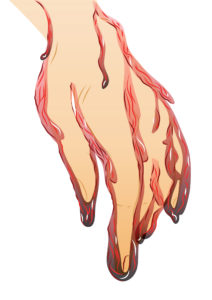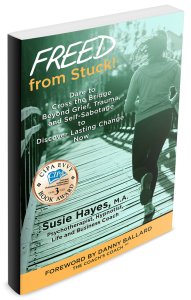“In the clinical world, it’s understood that deeply hidden issues can be the result of a loss, fear of loss, or trauma. While there are slightly different nuances to each, all three of these situations are used by our inner spirit to protect us from what it perceives as a dangerous situation. Because our inner spirit is always out to protect us, our trauma or loss is usually so concealed that we most likely have not detected its existence. . .
TRAUMA 101
What is Trauma?
Trauma is the experience of a real or perceived threat to life or injury, to yourself or someone you love. Trauma causes you to have an overwhelming sense of horror, helplessness and fear.
Trauma causes a powerful self-protective response of fight, flight or freeze. Review the symptoms of each below and note if you are having, or have experienced any of them.
- Fight – crying, clenching fists, grinding teeth, rage, glaring
- Flight – restlessness, running, fidgeting, anxiety, shallow breathing
- Freeze – numbness, stiffness, holding breath, coldness
How are we traumatized?
We can become traumatized in one of three ways, but we may not be aware of a trauma’s effect when it occurs.
- Direct personal experience
- Witness an event that involves death, injury or threat to the physical integrity of another person
- Learning about unexpected or violent death, serious harm, or threat of death or injury experienced by a loved one or close associate.
What events cause trauma?
Thoughtfully review the list below to determine if you have had any exposure to high risk events for trauma. If you have been through any of these events, the trauma related to them may be a leading cause of your stuck status. Keep the event and the possibility that it is a contributing factor to your problem in mind as you work through the rest of this chapter.
- Combat veterans, First Responders
- Natural disaster events – hurricanes, earthquakes, tornadoes, floods, fires, etc.
- High speed events – car or bike accidents, falls
- Assault events – assault, rape, incest, animal attacks
- Global threat events – drowning, electrocution, terrorist attacks
- Major illness/hospital events – cancer, heart attacks, surgery
- Cyclical trauma – anniversary of a major traumatic event
- Family trauma – divorce, affairs, death of loved ones
- Abandonment or attachment trauma – adoption, kidnapping, POWs, miscarriage
What are the most common symptoms of traumatic stress?
Have you been the victim of any these common symptoms of traumatic stress? Make a note of any you experience often and keep them in mind as you work through the rest of this chapter. Recognizing their relationship to the trauma you have experienced is the first step to alleviating them for good.
- Anxiety – trembling, shaking, feeling on edge, worrying, startling
- Fear – expressed in the fight, flight, or freeze
Responses
- Sustained emotions of grief, guilt, horror, terror, shock, hurt, frustration, or shame
- Depression – sadness, wanting to cry, feeling hopeless, loss of will to live, avoiding people, worthless feelings
- Dissociation – feeling outside the body, mind going blank, watching self from far away, not feeling like real self, frequent daydreaming, absent-mindedness
- Anger/Irritability/conflict – easily annoyed, provoking arguments, flared anger at unexpected times, yelling, striking out
- Intrusive experiences – nightmare, flashbacks, redirected thoughts to bad memories
- Sleep disturbance
- Fatigue
- Startle response – a reflexive reaction to sudden stimuli that is intended to protect us from danger.
- Sexual concerns – dissatisfied with sex life, negative thoughts or feelings during sex, confusion about sexual feelings, feeling shame about sexual thoughts, wishing to stop sexual thoughts
- Impaired self-reference – feeling empty inside, not knowing real self, not understanding own behavior, needing others to give instructions, feelings and thoughts dissuaded by others
- Feelings of obsession, intrusive thoughts, uncertainty, self-blame, fault-finding, resentment, hopelessness, helplessness
- Sense of a foreshortened future – “We’re going to die!”
How do we try to manage trauma?
Note below any of the defensive mechanisms you may be subconsciously adopting to manage stress caused by a trauma.
If you find yourself focusing on any of them, it is a good sign that you have a trauma that you need to recognize and handle.
- Defensive avoidance – trying to forget bad times; avoiding negative feelings or thoughts, avoiding people who cause discomfort, avoiding grief or regret, feeling numb from everything going on around you
- Hypervigilance – always being “on;” scanning theenvironment for signals of danger
- Overcontrol – feeling a need to control the behaviors of others, the environment, and one’s own expression of emotion
- Denial – refusing to acknowledge or accept a real event or emotion
- Rationalization – reframing and explaining an experience for the purpose of justification
- Intellectualization – using thought to avoid feeling
- Projection – placing on another what is unacceptable to accept in yourself
- Distraction – shifting focus away from pain, fear, trauma, or loss
- Addiction – engaging in a repetitive behavior that is compulsively stimulating/rewarding, while creating destruction and loss
How do we get stuck in trauma?
It is not the trauma event itself that is problematic; it is the unresolved trauma symptoms and dysfunctional defenses that cause the internal death of joy, serenity, hope and trust.
How do we get UNstuck in trauma?
Care needs to be provided at four levels. Review the various types of self-care you need, and note any that you should enhance.
Physical Care
- Eat healthy
- Exercise
- Sleep
- Play
- Vacation
- Cultivate healthy sexual experiences
- Maintain health care
Psychological Care
- Take time to reflect
- Journal
- Get personal therapy
- Decrease life stressors
- Be curious
- Dare to risk and try new things
Spiritual Care
- Find a spiritual connection or community
- Be open to inspiration
- Be open to not knowing
- Connect to nature
- Meditate
- Pray
- Sing
- Dance
- Create
Relationship Care
- Stay connected to tonic, not toxic, people
- Participate in meaningful, enjoyable, satisfying activities
- Set boundaries
- Avoid co-dependency, enmeshment and enabling relationships
- Allow authenticity in proven, trusted relationships – don’t be afraid to be yourself and allow others to be themselves
As you can tell, trauma affects so much more than it appears at first glance, and if we are unaware of the trauma or the signs pointing to the trauma, we will become stuck or remain stuck despite our best efforts to change.
To explain even further, trauma (I will use the word “trauma” to identify trauma, loss, and fear of loss) is an instinctive physiological reaction to danger or loss. We can experience trauma either directly or indirectly. Direct trauma occurs when we are face to face with an experience that is traumatic. For example, a person mugged while walking to work is likely to suffer direct trauma after the incident.
There can be varying degrees of trauma, depending on the severity of the event. For example, if you are in a horrific car accident where someone is killed or severely injured, that would be highly traumatic in contrast to the trauma created by a small fender-bender. Each individual’s reaction to a traumatic situation can be vastly different to others’ traumatic experiences, which can make dealing with trauma complicated for them. Regardless of the degree of trauma, however, the first step in the healing process is always to recognize that it has occurred.
There is also indirect or secondary trauma, which takes place when one observes an incident or experience happening to someone else. The fear response creates a self-preservation reaction which ignites trauma. For example, when 9/11 occurred back in 2001, North America was traumatized not because everyone was there when the towers collapsed, but because we observed it in the media. That trauma was reinforced over and over again by the repetitive looping of those images.
Explained another way, trauma is an instinctive response in which our fight, flight or freeze mechanism is activated. When something traumatic occurs, we have the choice to take flight and run away, fight back for self-preservation, or freeze; these are ways of protecting ourselves. Trauma becomes problematic when one freezes in that traumatic state.
HOW DOES TRAUMA STOP US FROM THINKING ABOUT THE FUTURE?
Looking forward in a positive manner, while in a frozen state caused by trauma, is a difficult task. Remember, we have three options when faced with a traumatic situation: to fight, to flee or to freeze.
When a traumatic event occurs, we instinctively focus on the experience, the loss and the pain and suffering. We stop momentarily to determine how to process the event and what to do with it in our mind.
If we never move out of that frozen state by staying focused on the fear, loss and suffering caused by the trauma, then that’s what causes us to be stuck. We are unable to look forward to the future as a result. Remember the three M’s: what we focus on magnifies, manifests and multiplies.
If we focus on what we fear and the experience that caused the trauma, it becomes magnified in our mind and emotionally freezes us. We become immobilized.
To get past that fear and move forward again, you must shift your focus away from the trauma to something else.
INDICATORS OF TRAUMA
A problem you have is often a symptom of a deeper trauma or loss, and will never be fixed until that trauma is recognized.
For example, Matt has had trouble advancing at work because he is hopelessly disorganized. Matt’s lack of organization inhibits him from showing his managers and coworkers his true ability to perform his job. Even after several reprimands by his boss for losing valuable customer records and leavinghis desk in a piled heap every night, Matt’s disorganization continues. He almost gets fired over what seems to be his reluctance to change.
Is the situation Matt’s problem? Certainly, there are countless resources available to improve his organizational skills. So, what is going on with Matt that prevents him from becoming more organized? It is highly likely that Matt’s underlying problem results from trauma or loss in his past. However, without some serious self-observation and contemplation, he will continue to see disorganization as the block that is keeping him stuck in his career.
I will be sharing with you an exercise you can use to probe your presenting problem further to help discover the hidden trauma or loss. But first, it can be helpful to recognize those presenting problems or indicators that could reveal an underlying trauma or loss:
- Procrastination
- Self-Sabotage
- Repetitive Patterns of Failure
- Inability to Sustain Intimacy
- Abuse – Being the abused or an abuser
- Sudden life change such as death of a loved one or
- Addiction
Certainly, other presenting problems can also indicate an underlying trauma, especially if you have had difficulty breaking past the blocks to resolve your problem.”
Excerpt copied by permission from the author:
Hayes, Susie. FREED from Stuck!: Dare to Cross the Bridge Beyond Grief, Trauma and Self-Sabotage to Discover Lasting Change Now (Kindle Locations 1112-1208). R50 Books. Kindle Edition, page 43-52.


